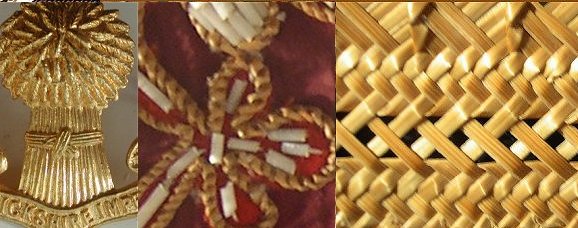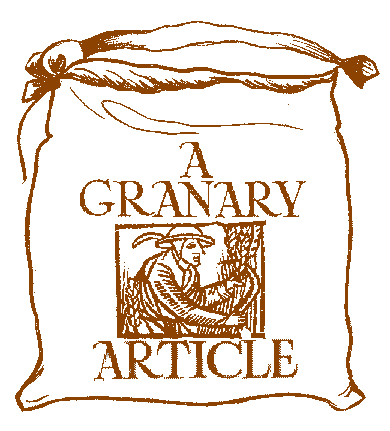
| 
| 
|

| 
| 
|


For Corn Dolly making and decorative straw work a hollow stemmed straw is required, with a good length between the head of the wheat and the first leaf node. Some of these varieties are available from specialist growers who supply to straw workers (see List of Suppliers,) or you may be fortunate enough to have a farmer near you who grows an old fashioned variety of long stemmed wheat specifically for thatching.
‘Corn’ is a generic term, and applies to all cereal crops – wheat, oats, rye, barley (and this term does of course include maize, but for our purposes this is discounted).
“The origin of Triticum vulgare – the common wheat – is uncertain. Vavilov, the great Russian scientist, after a vast research programme, concluded that Afghanistan was the source whence it spread via the trade routes of the world. The Romans possibly introduced it into England, and the Saxons probably followed up their conquest by introducing rye. Varieties of a near relation, Triticum turgidium, the bearded wheats, are still grown in parts of the world, notably in the Mediterranean basin. Triticum aestivum is the bread wheat class grown in this country from which we select our corn dolly material”. Alec Coker, The Craft of Straw Decoration
Here are some of the more common varieties still available today.
 MARIS WIDGEON - Long stemmed hollow robust winter wheat grown extensively for thatching.
MARIS WIDGEON - Long stemmed hollow robust winter wheat grown extensively for thatching.
 SQUAREHEADS MASTER - Long stemmed wheat with a large square reddish tinted head. This can look very attractive when made up into fans, braids, etc. but the outer seed case does tend to drop, giving a mottled effect to the head.
SQUAREHEADS MASTER - Long stemmed wheat with a large square reddish tinted head. This can look very attractive when made up into fans, braids, etc. but the outer seed case does tend to drop, giving a mottled effect to the head.
 ELITE LE PEUPLE - A long fine wheat with a nice shaped head; good for fine work.
ELITE LE PEUPLE - A long fine wheat with a nice shaped head; good for fine work.
 MASTERPIECE
MASTERPIECE
 TIMMO
TIMMO
 HUNTSMAN
HUNTSMAN
 BEARDED WIDGEON
BEARDED WIDGEON
 BLACK BEARDED WHEAT - Not grown in this country, though you may be able to purchase some from florists. Spectacular when used in fringes and fans, though it requires longer soaking. But beware, this is notorious for harbouring corn moth.
BLACK BEARDED WHEAT - Not grown in this country, though you may be able to purchase some from florists. Spectacular when used in fringes and fans, though it requires longer soaking. But beware, this is notorious for harbouring corn moth.
 OATS - Have a lovely colour and high sheen – excellent for straw marquetry.
OATS - Have a lovely colour and high sheen – excellent for straw marquetry.
 RYE - Wonderful for fine plaiting, but difficult to obtain.
RYE - Wonderful for fine plaiting, but difficult to obtain.
 BARLEY - Ordinary barley is of little use in plaiting as the stem is short and thin, though the heads can be incorporated as decoration. In marquetry it can be used with great effect as it can be buffed to produce a lustrous shine. The colour of the straw ranges from pale yellow (almost white and even pink) at the base of the stem to dark gold at the top of the stem.
BARLEY - Ordinary barley is of little use in plaiting as the stem is short and thin, though the heads can be incorporated as decoration. In marquetry it can be used with great effect as it can be buffed to produce a lustrous shine. The colour of the straw ranges from pale yellow (almost white and even pink) at the base of the stem to dark gold at the top of the stem.
 WILD OATS - Regarded as a weed and a pest in the cornfield, but makes beautiful corn dollies.
WILD OATS - Regarded as a weed and a pest in the cornfield, but makes beautiful corn dollies.
There are of course many more strains, but the old fashioned hollow long stemmed varieties are becoming increasingly difficult to obtain. The modern wheats grown for cereal crops have very thick walls, pithy stems, and only a short length between the head and first node. They are not really suitable for the purposes of making corn dollies or for other forms of decorative straw craft.
In olden times, when four seeds were planted in one hole, this prompted the following little rhyme:
Close planting of a normally robust plant will result in finer stalks.

It is best, if at all possible, to cut your own supplies yourself, before the reaper/binder harvests the crop. Cutting by hand, although labour intensive, results in far less damage to your working material. It should be done before the corn is fully ripe and has started to head over; there should still be a small amount of green visible at the first joint of the stalk and the kernels are still in the ‘milky’ stage (soft). By cutting while the corn is slightly green, as the grains are not yet fully ripened they are less likely to drop later. It will still dry out to a beautiful golden colour. Do not however cut it whilst it is very green, or the stem will just dry up and wither.
Wheat is a cash crop, and you will naturally have to pay the farmer for your sheaves, whether you cut them yourselves, or collect them from the field. Most farmers are quite amenable to you cutting your own, provided you respect their hard work, only cut in a small area and cause as little damage as possible to their crop. Depending on the size of the sheaf, you should get about 500 or so good undamaged working straws. With a reaper/binder there will be some damage to the outermost straws of the sheaf, and further damage when the sheaf is stooked. Wheat cut by combine harvester is no good whatsoever, as the stalks are too fragmented.
Cut with a sickle or shears, close to the ground. Corn stalks contain opaline silica, which will rapidly blunt your sickle or shears, so you will need to have a sharpening stone with you. Clear up the area after you have finished cutting what you require.
After use, always clean your sickle or shears thoroughly, sharpen, then lightly oil to prevent corrosion.
Your sheaves will need to dry out, so stand them upright in the sunshine for a couple of days to allow the moisture to drain down. Bring them in at night to avoid dampness from early morning dew. It is important that they dry out thoroughly. If you have the space, open out the sheaves, and turn the straw regularly. If it is allowed to remain damp you will soon discover to your dismay that the inner straws quickly become mouldy and black. A farmer growing wheat for thatching will leave the stooks standing for three weeks, so that any weed in the crop will die off. If his fields are weed free, then a week to ten days with good weather is sufficient to dry out the crop before it is brought in for combing.
If you have the time, you can strip and clean your straws for more convenience in storing. The important thing is that your straws are quite dry. They can then be stored, stripped or unstripped, for months or even years. Damp is your worst enemy, followed by mice, birds, and corn moth. Store in a dry airy place if possible. Cleaned and graded straws can be stored in boxes (preferably cardboard) but not in plastic bags, as the wheat may sweat in the heat and this will encourage the growth of mould.

Look at your stalk of corn, and you will see the different sections that make up the plant.
Your working straw for most Corn Dolly work will consist of the top section from the head down to the first node. Cut just above the node, and strip off the leaf or flag. You will find this task easier once the wheat has dried out a bit. If preparing while it is still quite damp, not only is the sheath difficult to strip away, but it can also cause slivers of the plant material to enter your finger if you are not extremely careful – and a wheat splinter can be very painful!
The straw between the first and second node can be utilised for padding out dollies that require a solid core, such as the Neck. It can also be useful for marquetry.
If you look at your prepared straw you will see that it tapers, being slightly smaller in diameter at the head (tip) end and larger at the node (butt) end. This enables you to join straws by inserting the tip end of a new working straw into the butt end of the previous one.
However, for plait work, it is essential that your working straws are evenly matched, and only the centre section of the working straw is used.
It is a good idea to grade your straws before storing; you will certainly need to do so before embarking on any project.

It is always interesting to visit agricultural museums to see the variety of tools that have been used over the centuries to bring in the harvest. Sickles and scythes, fagging hooks (used to pull a bundle of wheat towards you before cutting) etc. and nothing is more glorious than to see a reaper/binder in action in the field. Some are still in use today.
A range of tools is available for splitting straws. Split straw was used particularly in straw plaiting for the hat industry. Split and flattened straw is also used for straw marquetry.
Templates of various kinds are also available, to make leaf shapes, stars, etc. from whole straw, and delicate snow crystals, wheat ears, etc. from split or spun straw.
In order to work with your straw you will need to temper it, i.e. soak it sufficiently to render it pliable enough to plait, fold, twist or bend, without splitting or cracking. The amount of time required to temper your straw will vary considerably, depending on what weather conditions it has experienced during the growing stage. A long hot sunny summer will produce marvellous golden wheat, but these bleached and sun-dried straws will require a longer soaking time than wheat which has had intermittent periods of (in)temperate weather.
Place your prepared straws in a trough full of water (room temperature; boiling water or hot water is not necessary) and weigh them down with something to keep them submerged. After half an hour check if the butt end can be bent without cracking. Soaking time can take up to several hours, or even overnight. When suitably pliable, remove the straws from the water, drain off the excess moisture, and wrap in a damp towel. This will prevent your straws from drying out while you are working. It is advisable to try and estimate roughly how many straws you will require for your project, so that you are not left with a whole lot of soggy straws that will need drying out after you have finished your piece of work.
When your work is completed and pinned out or laid flat to dry, any left over straws should be removed from the water/damp towel, and allowed to dry out thoroughly. If they are left damp, they will soon go mouldy, or the heads will start sprouting, and they will smell! After thorough drying out they can be used again when required. Some people, if they intend to continue working later, wrap their damp straws in a plastic bag and place it in the freezer. When required, the straws are allowed to thaw out, and are ready tempered for use.
Hot water can be handy! If you have completed a long piece that requires to be bent into shape, such as a Horseshoe, a Staffordshire knot, or Mordiford, you can soak it in hot water for a few minutes until it is pliable enough to be formed into the required shape.
Once your plaiting is completed and the straw has dried out, you will find that your piece of straw work will hold its shape in whatever design you have made, and will be virtually indestructible. Some Corn Dollies seen in churches can be decades old; one Devon Neck hanging in Martinhoe Church is reputed to date from 1897, another dolly there is dated 1916. (Ref. Your Book of Corn Dollies by Joan Rendell, p43). It is unusual to see many old Corn Dollies because it was common practice to break up the one from the previous year and sow the grains in the spring with the new planting, but you may come across some in a museum.

More information to help you discover more about straw can be found by following the links below:
Straw versus Reeds A discussion on the merits of straw in thatching versus other materials and overcoming the problems of supply. Availability of the raw material is a problem we all have.
Resources
Events, Exhibitions and Courses
Articles
Projects